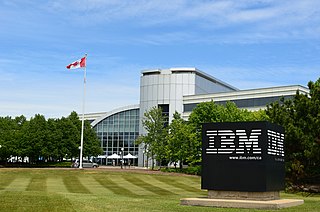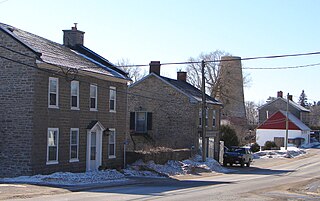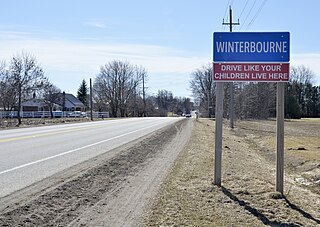
Prescott is a town on the north shore of the Saint Lawrence River in province of Ontario, Canada. The town is a part of the United Counties of Leeds and Grenville. In 2021, it had a population of 4,078. The Ogdensburg–Prescott International Bridge, 5 kilometres (3.1 mi) east of Prescott at Johnstown, crosses the Canada-United States border and connects the town with the city of Ogdensburg, New York.

Mount Forest is an unincorporated community located at the junction of Highway 6 and Highway 89 in the township of Wellington North, Ontario, Canada. As of the 2011 Canadian census the population of Mount Forest was 4,757.

Elizabethtown-Kitley is a township in eastern Ontario, Canada, in the United Counties of Leeds and Grenville. Its southern border lies along the St. Lawrence River and it extends north into many rural hamlets and villages. The township was created on January 1, 2001 by the amalgamation of the former Township of Elizabethtown and Township of Kitley.

Grenville County is a former county in the Canadian province of Ontario. It fronted on the north shore of the Saint Lawrence River, between the towns of Kingston and Cornwall. The county was created in 1792, and named in honour of William Grenville, 1st Baron Grenville, who was the British Secretary of State responsible for the colonies in 1790. It consisted of five townships, which were settled primarily by United Empire Loyalists in the late 1700s after the Revolutionary War. Prior to being settled by Europeans, the area was home to many generations of native cultures. Grenville County merged with Leeds County in 1850 to create Leeds and Grenville County. The county covered an area of 272,261 acres (110,180 ha).

Kemptville is a community located in the Municipality of North Grenville in Eastern Ontario, Canada in the northernmost part of the United Counties of Leeds and Grenville. It is located approximately 56 km (35 mi) south of the downtown core of Ottawa and 2.5 to 3 km south of the Rideau River.

Edwardsburgh/Cardinal is a township in the United Counties of Leeds and Grenville of eastern Ontario, Canada. Edwardsburgh township was first surveyed in 1783, and incorporated in 1850. The township was part of the historical Grenville County before it merged with Leeds County to form the United Counties in the 19th century.

Augusta Township is a township in the United Counties of Leeds and Grenville, located in eastern Ontario, Canada. Augusta is situated along the Saint Lawrence River, and extends back into rural hamlets. The township is located between the city of Brockville to the west, and the town of Prescott to the east.

Johnstown is a compact rural community in the United Counties of Leeds and Grenville, in eastern Ontario, Canada, part of the township municipality of Edwardsburgh/Cardinal. It is at the Canadian terminus of the Ogdensburg–Prescott International Bridge and at the southern termini of Highway 416 and Highway 16.

North Gower is a small village in eastern Ontario, originally part of North Gower Township, now part of the city of Ottawa. Surrounding communities include Richmond, Kemptville, Kars and Manotick. Public high school students in this area go to South Carleton High School in Richmond.

Blandford-Blenheim is a township in the Canadian province of Ontario, located in Oxford County. The township had a population of 7,359 in the Canada 2011 Census.

Milliken and Milliken Mills are neighbourhoods in the cities of Toronto and Markham. Milliken is situated in the north west section of Scarborough, whereas Milliken Mills is situated in the south-central portions of Markham. The neighbourhoods are centered on Kennedy Road and Steeles Avenue, the latter street serving as the boundary between the cities of Markham and Toronto.

Teeswater is a community in the municipality of South Bruce, Bruce County, Ontario, Canada. It is located 12 kilometres west of Mildmay, 16 kilometres north of Wingham on County Road 4, and 25 kilometres southeast of Ripley on Bruce Road 6. The population in 2016 was 995.

Maitland, Ontario is a small village within Augusta township in the United Counties of Leeds and Grenville, Canada. It is located along the St. Lawrence River approximately five kilometres (3 mi) east of the City of Brockville.
Shanly is an unincorporated place and Compact Rural Community in the township of Edwardsburgh/Cardinal in the United Counties of Leeds and Grenville in eastern Ontario, Canada. The village is about one hour south of Ottawa and around 7 miles north-west of Cardinal. Shanly is centred around the intersection of County Road 22, also known as Shanly Road, and County Road 21. Formerly these roads were the Nine Mile Road and the Seventh Concession, respectively. The community was settled during the 1800s, primarily as an agricultural community, and was at its height during the latter half of the 19th century, when many farms and a few businesses and factories were in operation. As of the 2000s, the rural area surrounding the main intersection consists of mostly residential properties and a few family farms. The village is also home to a few businesses and two churches.

Winterbourne is a village located to the east of the Grand River in the township of Woolwich in the Regional Municipality of Waterloo, Ontario, Canada. It is located just northeast of the city of Waterloo. The fine stonework of the Scottish stonemasons can be seen in many of the older buildings throughout the settlement.

Spencerville is a rural community located in Eastern Ontario, within Edwardsburgh/Cardinal township in the United Counties of Leeds and Grenville. The village lies about 80 kilometers southwest of downtown Ottawa on Highway 416. The South Nation River runs through the village.
Hagerman's Corners is a dispersed rural community in Markham, Ontario, Canada. Located at 14th Avenue and Kennedy Road, the former farm lands have disappeared and given way to homes and commercial parks. It is geographically located between the communities of Milliken Mills and Unionville, within the city of Markham.
Pickering Village is a former municipality and now a neighbourhood in the town of Ajax, within the Durham Region of Ontario, Canada. The Pickering Village derives its name from the former Pickering Township, which included the present-day town of Ajax and the city of Pickering. A small portion of the original settlement is now part of the Village East neighbourhood in the city of Pickering.

Wesley Mimico United Church is a church in Toronto, Ontario, Canada. It is located in the neighbourhood of Mimico in the former city of Etobicoke. The church was created by the union of the former Wesley Methodist Church, Mimico and St. Paul's Presbyterian Church in 1927, of which the Methodist church was the larger partner.

















